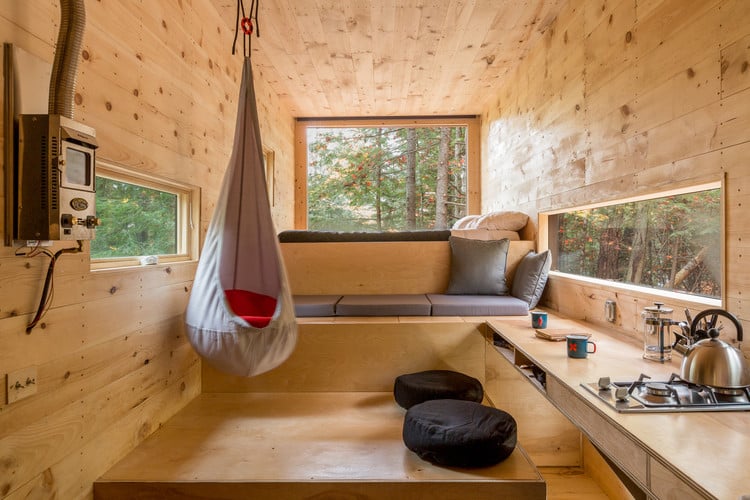In a world where bigger often means better, choosing to build tiny is a bold statement against the tide. It’s not just about cutting back on square footage; it’s about embracing simplicity, efficiency, and freedom in ways that traditional living spaces can’t offer. This journey into tiny living isn’t merely a trend—it’s a transformative lifestyle shift that challenges our views on space, value, and happiness. Dive into the essence of what it means to live more with less as we explore how building tiny opens up vast possibilities for personal and environmental well-being.
Simplifying Life with Tiny House Living
Embrace Minimalism
Choosing to build tiny means embracing a simpler way of life. You learn to live with less. This doesn’t mean sacrificing comfort or style. It’s about prioritizing what truly matters.
Tiny house living forces you to declutter your space and mind. You keep only what you need or love. The result? A cleaner, more organized home that brings peace and clarity.
Reduce Costs
One of the biggest benefits is the significant reduction in living costs. Tiny houses are cheaper to build and maintain than traditional homes. Here’s how you save money:
-
Lower utility bills due to smaller space.
-
Reduced spending on furniture and decorations.
-
Less temptation to buy unnecessary items because of limited storage.
These savings allow for a more flexible budget, possibly redirecting funds towards experiences rather than things.
Increase Mobility
Living tiny can also increase your mobility and freedom. Many tiny houses are built on trailers, allowing owners to travel with their home.
Imagine changing your scenery without giving up the comforts of home. Whether it’s mountains one month or beaches the next, your home comes along for the ride.
This lifestyle isn’t just about moving locations; it’s about embracing new experiences while maintaining a comfortable base.
Understanding Tiny House Pricing and Budget Considerations
Initial Costs
Building tiny can seem like a budget-friendly option at first. You might think it’s all about cutting down expenses. But, the initial costs are more than just buying a small plot of land and materials.
Firstly, you have to consider the price of designing your tiny home. Whether you’re going DIY or hiring professionals, each choice impacts your wallet differently. Then, there’s the construction itself. The cost varies widely depending on materials used and labor hired.
Long-Term Savings
However, don’t let initial costs scare you away. The long-term savings are significant.
Tiny houses often lead to lower utility bills thanks to their small size. Less space means less energy needed for heating or cooling. Also, many people choose eco-friendly options which further reduce monthly expenses.
Living in a tiny house means having less room for unnecessary purchases. This naturally leads to spending less money on things that don’t matter much in the long run.
Customization Costs
Customizing your tiny house is where budgets often inflate unexpectedly.
Want solar panels? Or maybe a custom-built loft bed? Each addition comes with its own price tag.
It’s crucial to prioritize what matters most to you in your tiny living experience and budget accordingly from the start.
Hidden Costs
Finally, there are hidden costs that many overlook:
-
Land: Even if it’s just a small lot.
-
Utilities hookup: Getting water and electricity can be expensive.
-
Insurance: Finding insurance for tiny homes can be tricky and sometimes costly.
Understanding these pricing elements helps set realistic expectations for building tiny while maintaining financial health over time.
Creating the Perfect Tiny House Living Space
Innovative Storage
To make a tiny house feel spacious, maximizing storage is key. Think about using the walls and ceilings. Shelves can hold books and decorations. Hooks can hang pots and pans.
Under-bed storage is another smart option. It hides away seasonal clothes or extra bedding easily.
Multifunctional Furniture
Choosing furniture that serves more than one purpose saves space. A sofa that turns into a bed offers a place to sit during the day and sleep at night.
Tables with hidden compartments provide room for work or dining while storing items inside. This way, you keep your living area clutter-free.
Light and Color
Incorporating natural light makes any space look bigger. Large windows let in sunlight, making rooms feel airy and open.
Using light colors on walls also helps reflect natural light better than dark colors do.
-
Light blue creates calmness.
-
Soft yellow brings warmth.
-
White gives a sense of cleanliness.
Exploring the Feasibility of Building a Tiny House
Legal Restrictions
Before diving into the tiny house trend, it’s crucial to check local zoning laws and restrictions. These rules can significantly impact where you can build your tiny home.
Many areas have strict regulations on minimum square footage. This could limit your ability to build tiny in certain locations. Always research or consult with local authorities before purchasing land or starting construction.
Land Availability
Finding the right spot is next. You need land that’s not only available but also suitable for a tiny house.
Consider factors like soil condition, access to utilities, and proximity to amenities. Some people opt for rural areas due to more lenient zoning laws and lower land costs. Others prefer urban settings for convenience despite potential challenges in finding appropriate plots.
DIY vs Professional
Deciding between DIY building or hiring professionals is crucial when planning your tiny house project.
-
DIY Pros:
-
Lower costs.
-
Personal satisfaction from building your own home.
-
DIY Cons:
-
Requires significant time investment.
-
Potential for mistakes if you’re inexperienced.
Hiring a professional builder might be more expensive but comes with benefits like expertise in navigating legal requirements and ensuring quality construction.
Step-by-Step Guide to Building a Tiny House
Planning Design
After considering the feasibility of building a tiny house, it’s time to dive into planning and designing your layout. This step is crucial. It sets the foundation for your entire project. Start by sketching out your ideas on paper or using design software.
Think about how you’ll use each space. Every inch counts in a tiny house. Include essential areas like sleeping, cooking, and bathroom facilities. Consider adding multipurpose furniture to save space.
Selecting Materials
Next, focus on selecting materials for your build. This decision impacts cost, quality, and sustainability.
Create a balance between these factors:
-
Cost: Look for deals but avoid compromising quality.
-
Quality: High-quality materials last longer but may cost more.
-
Sustainability: Eco-friendly options reduce environmental impact.
Consider using reclaimed wood or recycled metals to add character while being eco-conscious.
Navigating Building
The building process involves several steps from obtaining permits to adding finishing touches.
Firstly, research local regulations regarding tiny houses:
-
Zoning laws
-
Building codes
Securing permits ensures that your build is legal and safe.
Secondly, start constructing with these steps in mind:
-
Lay down the foundation securely.
-
Frame the structure carefully.
-
Install plumbing and electrical systems professionally.
-
Add insulation before closing up walls.
Finally, personalize with paint colors and interior decorations that reflect your style.
Highlighting Tiny House Building Workshops and Resources
Hands-on Learning
Finding the right workshop can make a big difference. Look for ones led by experienced builders. They often cover basics, from framing to finishing touches.
Workshops give you practical skills. You’ll learn how to use tools safely and efficiently. Plus, they’re great for meeting others who share your tiny house dreams.
Online Support
The internet is full of resources and communities eager to help. Websites like Tiny House Talk offer tips, while forums provide personalized advice.
YouTube channels run by tiny house enthusiasts are also invaluable. They show real-life building processes step-by-step.
Plans and Guides
Getting plans from seasoned builders is crucial. These guides ensure your project stays on track and avoids common pitfalls.
Many websites sell detailed plans tailored to different needs and skill levels.
-
For beginners: Simple designs with clear instructions.
-
For the experienced: More complex structures that allow for customization.
Exploring Build Tiny’s Projects and Designs
Unique Features
Build Tiny’s portfolio is a treasure trove of innovative designs. Each tiny house showcases unique features that cater to diverse lifestyles. For example, some homes have fold-out decks for outdoor enjoyment. Others include clever storage solutions to maximize space.
These features highlight the company’s ability to think outside the box. They make each project special. From retractable roofs for stargazing to multi-functional furniture, creativity shines in every corner.
Customization Options
One of Build Tiny’s strengths is customization. Clients can tailor their homes according to personal needs and preferences. You can choose from various floor plans, materials, and finishes.
Options range from minimalist designs for solo dwellers to spacious layouts for families. This flexibility ensures that everyone finds their perfect match in a tiny home.
Sustainability Practices
Sustainability is at the heart of Build Tiny’s construction methods. The company uses eco-friendly materials whenever possible. They also design homes that minimize energy consumption through efficient insulation and solar panels.
This commitment extends beyond materials and into thoughtful design choices that reduce environmental impact over time.
Finding the Easiest Way to Build a Tiny House
Prefab Kits vs. Custom
Building tiny can be simpler with prefabricated kits. These come ready-made, saving time and labor. You choose a design, and it arrives ready for assembly.
-
Pros: Cost-effective, quicker setup.
-
Cons: Less customization, might not meet specific needs.
On the other hand, custom builds offer full control over your tiny house design. They cater to personal preferences but require more effort and resources.
You work closely with architects or builders. This ensures every detail fits your vision perfectly.
Leveraging Technology
3D printing is revolutionizing tiny house construction. It allows for creating parts off-site with precision and efficiency.
This technology reduces waste significantly. It also speeds up the building process without sacrificing quality.
Imagine designing your dream home on a computer screen. Then watching it come to life layer by layer through a 3D printer!
Partnering Up
Working with a tiny house company simplifies the process immensely. They guide you from start to finish, ensuring no detail is overlooked.
They provide expert advice on:
-
Design choices.
-
Legal requirements.
-
Sustainable materials.
Choosing this route means less stress for you as they handle most of the heavy lifting.
Final Remarks
Diving into tiny house living is more than a trend; it’s a lifestyle choice that simplifies your world while challenging the norm. We’ve walked through the nuts and bolts of making this dream a reality, from budgeting to building, and even peeked into Build Tiny’s innovative designs. It’s clear that whether you’re crafting a snug haven or seeking an eco-friendly footprint, the journey to build tiny is packed with learning curves and rewarding milestones.
Now, it’s your turn to take the leap. With a toolbox of knowledge and resources at your fingertips, you’re more than ready to embark on this thrilling adventure. Remember, every big change starts with a tiny step. So why wait? Start sketching your tiny house dream today and join the growing community of tiny house enthusiasts. Let’s build not just tiny houses, but huge possibilities.


